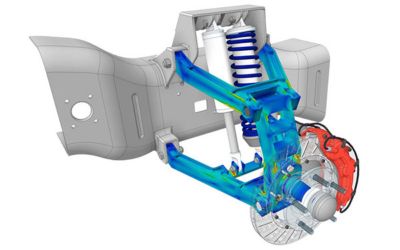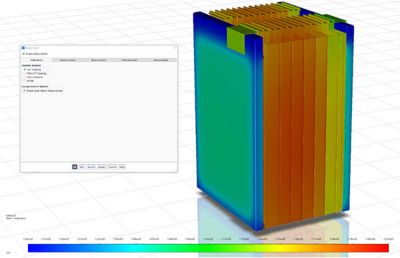-
United States -
United Kingdom -
India -
France -
Deutschland -
Italia -
日本 -
대한민국 -
中国 -
台灣
-
-
產品系列
查看所有產品Ansys致力於為當今的學生打下成功的基礎,通過向學生提供免費的模擬工程軟體。
-
Ansys Blog
July 15, 2020
Ansys 2020 R2: Simulation Innovation for the New Normal
The far-reaching business effects of the global pandemic are becoming apparent. Working from home on a global scale has altered the way products are designed and developed, accelerating the shift to a remote workforce, providing a more immediate return on digital transformation investments and spotlighting the importance of agile workflows.
According to a Gallup poll1, most U.S. employees working from home during COVID-19 want to continue to do so as much as possible. Gartner2 reports that more than half of Human Resources leaders pointed to poor technology and/or infrastructure as the biggest barrier to effective remote working. McKinsey & Co.3 partners write: “Never before has the need for accurate and timely data been greater.” The new normal is fast, technologically innovative and data-driven.
Ansys 2020 R2 delivers the engineering simulation and embedded software, high-performance computing (HPC) resources and platform solutions that you need to efficiently collaborate and innovate despite the challenges of the current business environment. It helps you accelerate innovation by harnessing new workflows and dynamic capabilities across Ansys’ solutions.
For example, Ansys Cloud updates include virtual desktop infrastructure (VDI) support that enhances Ansys’ simulation solutions with virtually unlimited cloud-based HPC that globally remote teams can leverage to work together. With Ansys VDI technology, any computer can be turned into a high-powered workstation capable of pre- and post-processing simulations from anywhere.
But efficient collaboration isn’t just about compute speeds. You need tools designed to increase your productivity as well. Ansys has enhanced solutions across our software platform to streamline your experience via user-friendly workflows. These workflow enhancements make it easier for teams to manage data and configurations, visualize dependencies, and capitalize on process integration and design optimization (PIDO) benefits as well as better materials management.
In the all new Ansys Discovery product the user experience has been completely reimagined to enable a new level of design exploration and refinement across thermal, structural, fluids and multiphysics simulation. Leveraging Ansys Discovery early in your product design processes will drive substantial gains in engineering productivity, spur innovation and improve your product’s overall performance. Ansys Discovery delivers instantaneous feedback as well as high-fidelity results on design changes so that every engineer can make more informed decisions at critical points in the design process.

The new Ansys Discovery seamlessly combines direct human-driven
interaction with generative algorithms to inspire new designs.
In a time when a distributed workforce has become the norm, Ansys’ digital twin solutions enable remote monitoring of assets and operations, which support predictive maintenance. Digital twins have taken on increased importance during the pandemic to decrease workplace risk via remote monitoring and automation. Ansys Twin Builder makes it quicker and easier to deploy and validate your digital twins with the introduction of Ansys Twin Deployer.
Collectively, these updates will help you generate larger, more complex designs easier and faster, increase productivity, spur development of high-quality products and expedite time to market.

Workflow improvements in Ansys Fluent streamline battery simulations
for conjugate heat transfer (CHT) setup in a single panel.
AV, Electrification and 5G Advances
Enhancements introduced in Ansys 2020 R2 also support emerging technologies, such as autonomous vehicles (AVs), electrification and 5G. Innovative and cutting-edge companies continue to redefine the state of the art in these markets by employing simulation.
VRXPERIENCE Driving Simulator powered by SCANeR provides a New Car Assessment Program (NCAP) scenario kit for AV function development, enabling simulation of NCAP testing scenarios for advanced driver assistance systems (ADAS) functions. Ansys SCADE Vision improves deployment, scalability and performance of AI-based perception software testing through multi-GPU parallelization. It offers automated integration with Ansys medini analyze, allowing the systematic identification of hazards to comply with new safety standards like Safety of the Intended Functionality (SOTIF).
On the electrification front, Ansys Fluent’s new battery capacity fade model predicts discharge time at high discharge rates. You can also predict battery capacity reduction based on calendar and cycle life via a new aging model. A new thermal and vibrational analysis coupled with Ansys’ electromagnetic field simulation software helps predict reliability and noise, vibration and harshness (NVH).

Ansys HFSS auto-computes the bio-compatibility of 5G equipment
and includes an enhanced HPC 3D Component domain
decomposition method (DDM) solver for array antennas.
Current and upcoming 5G rollouts mean you are designing and simulating increasingly complex antenna and integrated circuits (ICs). Ansys 2020 R2 advances phased array antenna analysis to enable you to simulate larger, more complex designs with scalable HPC. Additionally, you can take advantage of electronics reliability and electrothermal modeling advances for integrated circuit (IC), package and board workflows with the introduction of RaptorH — an electromagnetic simulation and extraction tool. Ansys HFSS enhancements combine on-chip device modeling with 3D electromagnetic simulation software for verification for sensitive ICs.
That’s a lot, but there is so much more in Ansys 2020 R2. For all the updates, check out the Ansys 2020 R2 highlights.











